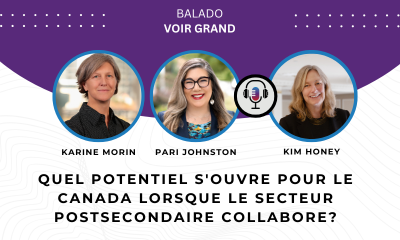Sponsored by University Affairs, the May 16 Career Corner session entitled “Collecting and Communicating the Evidence of Impact” featured Connie Tang and David Phipps of Research Impact Canada. Connie began the session by asking the audience a critical question: “What does making an impact mean to you?” She then shared a homegrown impact snapshot: the development of pulse crops, a collaboration between Professor Al Slinkard of the University of Saskatchewan with Agriculture Canada and local farmers. Professor Slinkard’s research led to a six-fold increase in the value of crop yields, making Saskatchewan the world’s leading exporter of chickpeas and lentils. Although this was a significant example of impact, the rationale behind Connie’s initial question was that, “Impact isn’t just financial impact. It can look a variety of different ways.” Similarly, David noted that people often ask him, “How can I measure impact?” However, measurement is the wrong word, he explained, as it suggests that impact must be quantifiable.
“Rather than measure or assess, we collect and communicate evidence of impact,” said David.
Following a discussion on the importance of knowledge mobilization, the session moved towards the Co-Produced Pathway to Impact Model — a model in which a partnership is formed between an academic researcher and their co-production partner(s), involving research, dissemination, uptake, implementation, and impact. David shared the benefits of each stage, ranging from the generation of new knowledge to changed public awareness. He then discussed the five elements of a knowledge mobilization strategy: partners/audiences, goals, activities, impact assessment, and budget.
As the focus of this particular session was on impact, David subsequently highlighted the notion of research impact literacy, taking the audience through the processes and elements to achieve impact, its demonstrable benefits, as well as the skills and people-based factors that can lead to its achievement. The session concluded with an introduction to Research Impact Canada’s tool for collecting and communicating the evidence of research beyond academia. This tool, which includes guidelines for its use, an interview guide, and a case study template, is available in English and French. It is especially useful in that researchers can amend and adapt it for their particular contexts.
Overall, this session was highly impactful, yielding much food for thought for all attendees!

Quel potentiel s'ouvre pour le Canada lorsque le secteur postsecondaire collabore?
← Page d'accueil du balado Voir Grand Introduction | À propos des invitées | Retranscription | Suivez nous Introduction L’avenir du Canada se dessine dans les lieux où les individus apprennent et dans la manière dont ces lieux sont reliés entre eux...

Le leadership du Canada en matière d'IA nécessite la participation de tou.te.s les expert.e.s
Après avoir réuni des experts en IA issus des sciences humaines pour une consultation avec le groupe de travail sur la stratégie en matière d'IA du gouvernement fédéral le 20 octobre, la Fédération a soumis le document suivant le 31 octobre...

Bâtir un avenir solide pour la recherche grâce au Budget fédéral 2025
Le 4 novembre 2025, le gouvernement fédéral a déposé son Budget 2025 « Un Canada fort ». De par son investissement visant à attirer des talents internationaux, ce budget reconnait l’importance cruciale du travail des chercheur.euse.s. Le Budget 2025...
